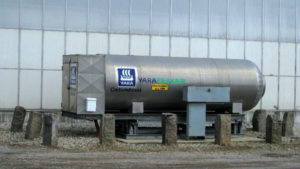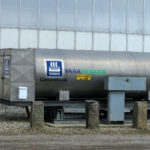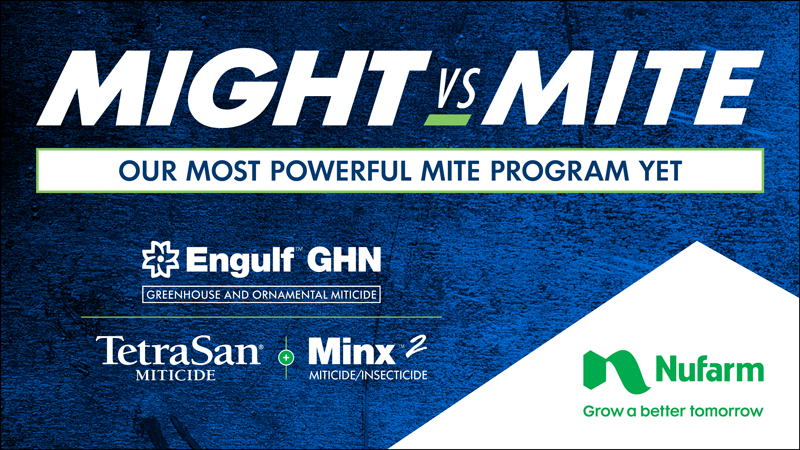Monitoring Carbon Dioxide in the Greenhouse

A refrigerated carbon dioxide (CO2) tank outside a greenhouse. Photo by Roberto Lopez.
In addition to temperatures conducive to growth, light (photosynthetically active radiation; PAR, which was covered in part 3 of this series), water, and nutrients, plants also require carbon dioxide (CO2) for photosynthesis (carbon assimilation), which ultimately affects plant growth, vigor, and vegetable and cut flower yield. Carbon dioxide is an odorless and colorless trace gas. Today, ambient CO2 levels outdoors comprise 0.04% of atmospheric volume, or around 400 μmol∙mol−1 (or parts per million, ppm). Plants take up CO2 by diffusion, through small pores called stomates that are primarily located on the underside of leaves. The opening and closing of stomates can be influenced by leaf and air temperatures, light levels, humidity, water stress, CO2 concentration, and oxygen (O2) in the air and leaf. Thus, if any of these environmental or cultural factors used for photosynthesis are limiting in the greenhouse, plant growth and yield are less.
Until recently, the vast majority of growers in the U.S. did not measure CO2 or use it to enrich their greenhouses. However, during the winter, CO2 levels can quickly become limiting in unventilated greenhouses full of plants on cold and sunny days. Over the past 10 years, we have also seen greenhouse growers seal up their greenhouses in an effort to control their heating bills during the winter. Other growers, especially in northern latitudes, have invested in supplemental lighting because of the numerous benefits, from improved quality and yields to reduced production time. An apparent result of tightly sealing the greenhouse is increased humidity and condensation. A not-so-apparent result of reducing air infiltration is a reduction of CO2 levels within the greenhouse below ambient levels found outdoors.
During the day, plants are using CO2, water, and light energy from the sun and/or supplemental lighting to photosynthesize. Therefore, the more CO2 and PAR plants receive to species-specific saturation levels, the faster they photosynthesize, grow, and produce flowers and fruit. On the contrary, if either of these two environmental parameters are limiting, photosynthesis is not maximized. Therefore, growers with supplemental lighting and a tightly sealed greenhouse may not be realizing the full benefits of their investment if CO2 levels are suboptimal. In fact, measurements conducted by the USDA-ARS lab in Toledo, OH, have found that on average, CO2 levels can range from 300 to 330 ppm during the winter, which is 18% to 25% lower than ambient levels outdoors. In extreme cases, levels can be as low as 175 to 200 ppm.

Examples of digital carbon dioxide (CO2) meters and controllers. Some meters can be connected to a computer to monitor and maintain set point maximum and minimum carbon dioxide levels. Photo by Roberto Lopez.
How Do You Monitor and Control CO2?
A CO2 meter is needed to both monitor CO2 and control CO2 enrichment in the greenhouse. Handheld, stationary, and computer-controlled sensors are available and vary in their level of sophistication and accuracy. Similar to quantum sensors, CO2 meters should be placed close to the crop and in a location that is representative of the entire greenhouse. Computer-controlled sensors and controllers can be used to monitor and maintain set point maximum and minimum CO2 levels. Therefore, the controller can inject CO2 from compressed or liquid sources, or be used to turn CO2 burners on or off. Additionally, CO2 levels can be integrated with other environmental parameters such as ambient and supplemental light intensity, temperature, and ventilation. As with all sensors, CO2 sensors should be periodically calibrated to ensure accuracy.
What Can You Do to Increase CO2 in the Greenhouse?
There are multiple methods used to enrich CO2 in the greenhouse and indoor production facilities. Vegetable, flower, potted plant, and young plant growers will typically use different approaches and rates of CO2 enrichment.
The cost of enrichment depends on the method used, number of hours of operation, air leakage, and ventilation frequency. Greenhouses can use compressed or liquid CO2 depending on the quantity of CO2 they will use. The compressed CO2 is converted from a liquid to a gas and then released into the greenhouse.
Carbon dioxide is often distributed under the crop canopy in vegetable or cut flower production greenhouses via small, inflated polyethylene tubes or under benches for potted plants. The tubes have small holes that allow uniform distribution of CO2 across the greenhouse, similar to inflation tubes used to distribute warm air.

Inflated polyethylene tube used to distribute carbon dioxide (CO2) under the plant canopy. Small holes along the length of the inflated tube allow carbon dioxide to diffuse into the air. Photo by Roberto Lopez.
Growers can also use CO2 burners or generators for CO2 enrichment. This method produces some heat, moisture, and CO2 by burning natural gas or propane. Be aware that incomplete combustion or contaminated fuels can lead to the introduction of toxic gases for both plants and humans. To increase uniformity, burners are placed just above the crop, and are distributed throughout the greenhouse and away from flammable sources such as blackout, energy, or shade curtains. Generally, a single burner can cover an area of approximately 4,800 square feet. However, the size of your burner and horizontal airflow in the greenhouse will ultimately determine the number of burners needed and their placement.
Since photosynthesis of most plants occurs during the day, CO2 enrichment is not required at night. The typical recommendation is to provide CO2 enrichment when CO2 levels in the greenhouse are below ambient levels. For operations that want to enrich the CO2 levels in their greenhouse above ambient levels, concentration no higher than 1,000 to 1,200 ppm is recommended when ventilation is not occurring. For maximum benefits, CO2 enrichment should occur one hour after sunrise and end two to three hours before sunset. When supplemental lighting is used during the night, CO2 enrichment should also be used to maximize photosynthesis.












